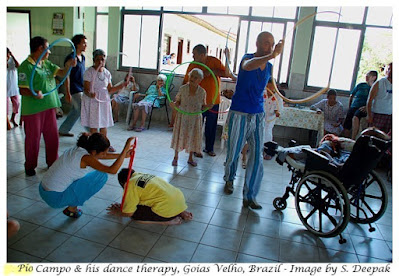In today's FirstPost, an online newspaper from India, there is a cover story on Neglected Tropical Diseases (NTDs) by Kalikesh Singh Deo, "a member of the Biju Janata Dal party. He is the Convenor of the National Coalition on Neglected Tropical Diseases and Malaria".
I have some concerns about the use of term "elimination" for reducing the number of certain diseases like Kala Azar and Lymphatic Filariasis, under the guidance of the World Health Organisation (WHO). I hope that bodies advising the Government of India would have discussions with stakeholders to ensure a reduction in the negative fall-out from the use of such terminology.
Let me explain why I think that using terms like "elimination" in such campaigns is a double-edged sword. (The image below presents some ASHA workers from Maharashtra, India - all public health programmes reach people through these front-line workers in India - without them no campaign or programme can work). (Click on the images for a bigger view)
WHO's Definitions
In 2016, WHO produced a document about the use of terms like "elimination". According to this document, the following terms have following meanings for the infectious diseases (page 3):
Control: Reducing the number of cases of a disease
Elimination: Reducing a disease to zero new cases (incidence) in a country or an area
Eradication: The causative organism has been eradicated from nature and laboratories so that it can not cause any new infection
In addition, there is a 4th definition, which is called "Elimination as a Public Health Problem" - this means reducing the numbers of cases of a disease so it is no longer a problem for the health services.
Advantages of Using terms like Elimination
In his article, K.S. Deo explains: "By December 2023, the Government of India plans to reduce kala-azar cases to less than one per 10,000 people at the block level and, by 2030, to eliminate haati pao as well."
Reading the strategy and such explanations, the readers feel that the problem is going to be solved. In this article, he does not use the term "elimination as a public health problem" because he understands that this won't make much sense to ordinary readers.
There are different advantages of using words like "elimination", including getting more resources from the Government and greater commitment from health services and health personnel.
There are real gains on the ground as well. For example, Deo writes: "10 February 2023, India will conduct Mass Drug Administration (MDA) rounds in Mission Mode in 10 affected states". This means that a large number of people will receive medicines to treat and to prevent new infections.
Disadvantages of Using Terms like Elimination
The first time the term "elimination as a public health problem" was used was in 1991, when WHO had launched its Leprosy Elimination Strategy (LES) - to reduce leprosy by the year 2000. At that time I was a member of the the medical commission of the International Leprosy Associations Federation (ILEP) and many of our members had concerns that people will not understand the term "elimination as a public health problem" and will think that the disease has been eliminated, they will believe that it no longer requires resources and services.
The LES had a huge impact in India. In most of north India very few public health services were reaching leprosy patients and most of them were being treated by older lesser-effective medicines. For example, due to LES, by 1998 even states like Bihar and UP managed to provide almost 100% coverage with newer and more effective anti-leprosy drugs to all those who needed them.
The problem came after India had reached the LES goal (in 2005). Many states reduced their support for leprosy services. It was not only decision-makers or general population who had thought that leprosy will be actually eliminated and there won't be any more new cases, even doctors and public health specialists believed it.
For example, 4 years ago, Dr Madhukar Pai, director of McGill International TB Centre and a well-known and influential public health specialist based in Canada, in his article "Failures of Public Health" wrote the following:
In 2005, India declared leprosy to be eliminated and scaled-back on its leprosy programmes. Today, according to WHO, India harbors 60 percent of the world’s cases, with more than 100,000 new diagnoses each year
I can tell many anecdotes of people coming up to me with questions about why governments had declared "leprosy is eliminated" when they still had the disease. I have even seen a sociology thesis from a country in Africa, which had a theory about the LES declaration and a national conspiracy to marginalise the poor persons for the benefit of the rich.
Conclusions
I think that it will be good if Mr. K.S. Deo and his team will bring together different stakeholders, including representatives of leprosy-organisations to find ways which allow us to use the term "elimination" for the advantages it provides and at the same time, find alternate ways to mitigate the damage caused people's expectations that these diseases will disappear.
For example, it might be important to use some other word and not use the word "elimination" in the local language translations about the campaigns.
18 years after Eliminating Leprosy as a public health problem in India, it continues to be a public health problem and is a part of NTD strategy about which Deo has written. LES had an impact, the number of new cases of leprosy in India has been halved (partly this may be due to covid-related reduction in services, so that many new cases were not detected) but the disease is still there and it requires services. It is crucial to avoid mistakes of the past.
*****

.jpg)




















